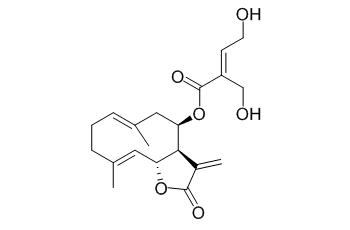Eupatoriopicrin
Eupatoriopicrin shows anti-trypanosomal activity and cytotoxicity against Trypanosoma brucei rhodesiense. Eupatoriopicrin-induced DNA damage may play a role in the observed cytotoxicity, it shows a weak sensitizing capacity in guinea pigs.
Inquire / Order:
manager@chemfaces.com
Technical Inquiries:
service@chemfaces.com
Tel:
+86-27-84237783
Fax:
+86-27-84254680
Address:
1 Building, No. 83, CheCheng Rd., Wuhan Economic and Technological Development Zone, Wuhan, Hubei 430056, PRC
Providing storage is as stated on the product vial and the vial is kept tightly sealed, the product can be stored for up to
24 months(2-8C).
Wherever possible, you should prepare and use solutions on the same day. However, if you need to make up stock solutions in advance, we recommend that you store the solution as aliquots in tightly sealed vials at -20C. Generally, these will be useable for up to two weeks. Before use, and prior to opening the vial we recommend that you allow your product to equilibrate to room temperature for at least 1 hour.
Need more advice on solubility, usage and handling? Please email to: service@chemfaces.com
The packaging of the product may have turned upside down during transportation, resulting in the natural compounds adhering to the neck or cap of the vial. take the vial out of its packaging and gently shake to let the compounds fall to the bottom of the vial. for liquid products, centrifuge at 200-500 RPM to gather the liquid at the bottom of the vial. try to avoid loss or contamination during handling.
Antioxidants2022, 11(2),234.
Molecules.2023, 28(8):3503.
Molecules.2020, 25(23):5556.
Drug Test Anal.2018, 10(10):1579-1589
Pamukkale Medical Journal2022, 15(4):796-803.
Acta horticulturae2017, 1158:257-268
Food Sci Biotechnol.2024, 33(15):3629-3637.
Bioorg Chem.2024, 152:107720.
Metabolites.2023, 13(5):625.
Int J Mol Sci.2020, 21(19),7070.
Related and Featured Products
Fitoterapia. 2011 Oct;82(7):955-9.
Antitrypanosomal sesquiterpene lactones from Saussurea costus.[Pubmed:
21624443 ]
In the course of a larger screen of 1800 plant and fungal extracts, the ethyl acetate extract of Saussurea costus roots potently inhibited the growth of Trypanosoma brucei rhodesiense. Subsequent HPLC based activity profiling led to the identification of the sesquiterpene lactones arbusculin B (1), α-cyclocostunolide (2), costunolide (3), and dehydrocostuslactone (4).
METHODS AND RESULTS:
They were tested for in vitro antitrypanosomal activities and cytotoxicity alongside the structurally related sesquiterpene lactones parthenolide (5), zaluzanin D (6), and Eupatoriopicrin (7), and had IC(50)s between 0.8 and 22 μM.
Cytotoxic IC(50)s were from 1.6 to 19 μM, and selectivity indices from 0.5 to 6.5.
Nat Toxins. 1997;5(6):223-7.
Allergenic sesquiterpene lactones from Eupatorium cannabinum L. and Kaunia rufescens (Lund ex de Candolle).[Pubmed:
9615309]
METHODS AND RESULTS:
From Eupatorium cannabinum L., a hitherto unknown alpha-methylene-gamma-butyrolactone, 3 beta-peroxyeucannabinolide, was isolated. This compound and Eupatoriopicrin from the same plant showed a weak sensitizing capacity in guinea pigs.
CONCLUSIONS:
2-oxoludartin and dehydroleucodin, isolated from Kaunia rufescens (syn. Eupatorium rufescens), were strong sensitizers in the same sensitizarian procedure.
Biochem Pharmacol. 1989 Jul 15;38(14):2279-83.
Induction of DNA damage in Ehrlich ascites tumour cells by exposure to eupatoriopicrin.[Pubmed:
2751694]
The sesquiterpene lactone Eupatoriopicrin (EUP) from Eupatorium cannabinum L. has been shown to be cytotoxic in a glutathione (GSH)-dependent way. In order to assess possible DNA damage as a cause for cell death, the study reported was initiated.
METHODS AND RESULTS:
After 2 hr incubation of Ehrlich ascites tumour cells with EUP, the DNA damage, determined by the use of an alkaline DNA unwinding method, followed by hydroxylapatite column chromatography of degraded DNA, was observed at concentrations only slightly higher than those causing cell death in a clonogenic assay. The amount of EUP, requested to demonstrate DNA damage after a 24-hr post-incubation period lay within the concentration range that was effective in the clonogenic assay (1-10 micrograms/ml). Glutathione (GSH) depletion of the cells to about 99%, by use of buthionine sulphoximine (BSO), enhanced the extent of DNA damage.
CONCLUSIONS:
It is concluded that EUP-induced DNA damage may play a role in the observed cytotoxicity.



